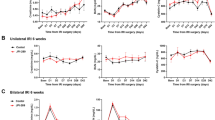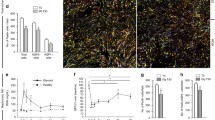Summary
To elucidate the role of apoptosis and cell desquamation in the repair phase of acute tubular necrosis, morphological findings after 60 min ischaemia were investigated in rats. A morphometric analysis of the cell proliferation and of the epithelial cellularity of reconstructing tubules was performed. The kinetics of apoptosis and cell desquamation were also examined. Ischaemia and reperfusion injury resulted in widespread necrosis of tubules at day 1. Subsequently, a regenerative epithelial hyperplasia took place in the aarly stage. The most marked increase in cellularlity in the damaged tubules was on day 6, when the tubules became lined by hyperplastic epithelial cells with papillary clusters. The number of papillary clusters decrease up to day 8, and during this period many desquamated cells from the clusters were observed in the tubular lumen. In the later stage, hyperplastic epithelial cells were reduced to their original cellularity and during this period the number of apoptotic cells obviously increased, while the damaged tubules were reconstructed. We conclude that epithelial over-production occurs in the early phase after tubular necrosis, and excess hyperplastic epithelial cells regress during the repair process by cell desquamation and apoptosis, both of which are essential for the recovery of the original tubular structure.
Similar content being viewed by others
References
Bhathal PS, Gall JAM (1985) Deletion of hyperplastic biliary epithelial cells by apoptosis following removal of the proliferative stimulus. Liver 5:311–325
Bursch W, Lauer B, Timmermann-Trosiener I, Barthel G, Schuppler J, Schulte-Hermann R (1984) Controlled death (apoptosis) of normal and putative preneoplastic cells in rat liver following withdrawal of tumor promoters. Carcinogenesis 5:453–458
Columbano A, Ledda-Columbano GM, Coni PP, Faa G, Liguori C, Cruz GS, Pani P (1985) Occurrence of cell death (apoptosis) during the involution of liver hyperplasia. Lab Invest 52:670–675
Cuppage FE, Tate A (1967) Repair of the nephron following injury with mercuric chloride. Am J Pathol 51:405–429
Cuppage FE, Tate A (1968) Repair of the nephron in acute renal failure: comparative regeneration following various forms of acute tubular injury. Pathol Microbiol 32:327–344
Cuppage FE, Neagoy DR, Tate A (1967) Repair of the nephron following temporary occulusion of the renal pedicle. Lab Invest 17:660–674
Cuppage FE, Cunningham N, Tate A (1969) Nucleic acid synthesis in the regenerating nephron following injury with meruric chloride. Lab Invest 21:449–457
Cuppage FE, Chiga M, Tate A (1972) Cell cycle studies in the regenerating rat nephron following injury with mercuric chloride. Lab Invest 26:122–126
Daoust R, Morais R (1986) Degenerative changes, DNA synthesis and mitotic activity in rat liver following single exposure in diethylnitrosamine. Chem Biol Interact 57:55–64
Ganote CE, Reimer KA, Jennings RB (1974) Acute mercuric chloride nephrotoxicity: an electron microscopic and metabolic study. Lab Invest 31:633–647
Glaumann B, Trump BF (1975) Studies of the pathogenesis of ischemic cell injury. III. Morphological changes of the pars recta proximal tubules (P3) of the rat kidney made ischemic in vivo. Virchows Arch [B] 19:303–323
Glaumann B, Glaumann H, Berezesky IK, Trump BF (1975) Studies of the pathogenesis of ischemic cell injury. II. Morphological changes of the pars convoluta (P1 and P2) of the proximal tubule of the rat kidney made ischemic in vivo. Virchows Arch [B] 19:281–302
Glaumann B, Glaumann H, Berezesky IK, Trump BF (1977a) Studies on cellular recovery from injury. II. Ultrastructual studies on the recovery of the pars convoluta of the proximal tubule of the rat kidney from temporary ischemia. Virchows Arch [B] 24:1–18
Glaumann B, Glaumann H, Trump BF (1977b) Studies on cellular recovery from injury. III. Ultrastructual studies on the recovery of the pars recta of the proximal tubule (P3 segment) of the rat kidney from temporary ischemia. Virchows Arch [B] 25:281–308
Gobe GC, Axelsen RA (1987) Genesis of renal tubular atropy in experimental hydronephrosis in the rat. Role of apoptosis. Lab Invest 56:373–381
Gobe GC, Axelsen RA, Searle JW (1990) Cellular events in experimental unilateral ischemic renal atrophy and in regeneration after contralateral nephrectomy. Lab Invest 63:770–779
Gratzner HG (1982) Monoclonal antibody to 6-bromo and 5-iododeoxyuridine: new reagent for detection of DNA replication. Science 218:474–475
Haagsma BH, Pound AW (1980) Mercuric chloride-induced tubulonecrosis in the rat. Br J Exp Pathol 60: 341–352
Haagsma BH, Pound AW (1980) Mercuric chloride-induced tubulonecrosis in the rat kidney: the recovery phase. Br J Exp Pathol 61: 229–241
Harmon BV, Corder AM, Collins RJ, Gobe GC, Allen J, Allen DJ, Kerr JFR (1990) Cell death induced in a murine mastocytoma by 42–47° C heating in vitro: evidence that the form of death changes from apoptosis to necrosis above a critical heat load. Int J Radiat Biol 58:845–858
Kerr JFR (1971) Shrinkage necrosis: a distinct mode of cellular death. J Pathol 105:13–20
Kerr JFR, Wyllie AH, Currie AR (1972) Apoptosis: a basic biological phenomenon with wide-rangeing implications in tissue kinetics. Br J Cancer 26:239–257
Kriss JP, Revesz L (1962) The distribution and fate of bromode-oxyuridine and bromodeoxycytidine in the mouse and rat. Cancer Res 22:254–265
Ledda-Columbano GM, Columbano A, Coni P, Faa G, Pani P (1989) Cell deletion by apoptosis during regression of renal hyperplasia. Am J Pathol 135:657–662
Oates PS, Morgan RGH, Light Am (1986) Cell death (apoptosis) during pancreatic involution after raw soya flour feeding in the rat. Am J Physiol 250:G9-G14
Oliver J (1953) Correlations of structure and function and mechanisms of recovery in acute tubular necrosis. Am J Med 15:535–557
Olsen TS, Olsen HS, Hansen HE (1985) Tubular ultrastructure in acute renal failure in man: epithelial necrosis and regeneration. Virchows Arch [A] 406:75–89
Olsen S, Burdick JF, Keown PA, Wallace AC, Racusen LC, Solez K (1989) Primary acute renal failure (“acute tubular necrosis”) in the transplanted kidney: morphology and pathogenesis. Medicine 68:173–187
Racusen LC (1992) Biology of disease. Alterations in tubular epithelial cell adhesion and mechanisms of acute renal failure. Lab Invest 67:158–165
Reimer KA, Ganote CE, Jennings RB (1972) Alterations in renal cortex following ischemic injurry. III. Ultrastructure of proximal tubules after ischemia or autorysis. Lab Invest 26:347–363
Schumer M, Colombel MC, Sawczuk IS, Gobe G, Connor J, O'Toole KM, Olsson CA, Wise GJ, Buttyan R (1992) Morphologic, biochemical, and molecular evidence of apoptosis during the reperfusion phase after brief periods renal ischemia. Am J Pathol 140:831–838
Searle J, Kerr JFR, Bishop CJ (1982) Necrosis and apoptosis: distinct modes of cell death with fundamentally different significance. Pathol Annu 17:229–259
Siegel FL, Rulger RE (1975) Scanning and transmission electron microscopy of mercuric chloride-induced acute tubular necrosis in rat kidney. Virchows Arch [B] 18:243–262
Toback FG (1992) Regeneration after acute tubular necrosis. Kidney Int 41:226–246
Verani RR, Brewer ED, Ince A, Gibson J, Bulger RE, Gibson J, Bulger RE (1982) Proximal tubular necrosis associated with maleic acid administration to the rat. Lab Invest 46:79–88
Weinberg JM (1991) The cell biology of ischemic renal injury. Kidney Int 39:476–500
Wyllie AH, Kerr JFR, Currie AR (1980) Cell death: the significance of apoptosis. Int Rev Cytol 68:251–306
Wyllie AH (1987) Apoptosis: cell death under homeostatic control. Arch Toxical [Suppl] 11:3–10
Author information
Authors and Affiliations
Rights and permissions
About this article
Cite this article
Shimizu, A., Yamanaka, N. Apoptosis and cell desquamation in repair process of ischemic tubular necrosis. Virchows Archiv B Cell Pathol 64, 171–180 (1993). https://doi.org/10.1007/BF02915110
Received:
Accepted:
Issue Date:
DOI: https://doi.org/10.1007/BF02915110




